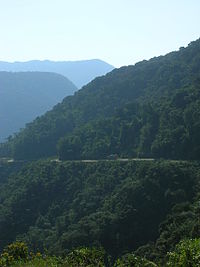- Yungas Road
-
This article is about the road in Bolivia. For other notably dangerous roads, see Slaughter alley.
 Yungas Road at San Pedro waterfall
Yungas Road at San Pedro waterfall
The North Yungas Road (alternatively known as Grove's Road, Coroico Road, Camino de las Yungas, El Camino de la Muerte, Road of Death or Death Road) is a 61-kilometre (38 mi) or 69-kilometre (43 mi) road[1] leading from La Paz to Coroico, 56 kilometres (35 mi) northeast of La Paz in the Yungas region of Bolivia. It is legendary for its extreme danger and in 1995 the Inter-American Development Bank christened it as the "world's most dangerous road".[2][3][4] One estimate is that 200 to 300 travellers are killed yearly along the road.[4] The road includes crosses marking many of the spots where vehicles have fallen.
A South Yungas Road (Chulumani Road) exists that connects La Paz to Chulumani, 64 kilometres (40 mi) east of La Paz, and is considered to be nearly as dangerous as the North Road.[citation needed]
Photographs of China's Guoliang Tunnel are often incorrectly identified as showing the Yungas Road.[5]
Contents
Route description
The Yungas Road, as it descends into the rainforest
It is one of the few routes that connects the Amazon rainforest region of northern Bolivia, or Yungas, to its capital city. Upon leaving La Paz, the road first ascends to around 4,650 metres (15,260 ft) at La Cumbre Pass, before descending to 1,200 metres (3,900 ft) at the town of Coroico, transiting quickly from cool Altiplano terrain to rainforest as it winds through very steep hillsides and atop cliffs.
Because of the extreme dropoffs of at least 600 meters (1,830 feet), single-lane width – most of the road no wider than 3.2 metres (10 ft) and lack of guard rails, the road is extremely dangerous. Further still, rain, fog and dust can reduce visibility. In many places the road surface is muddy, and can loosen rocks from the road.[6]
One of the local road rules specifies that the downhill driver never has the right of way and must move to the outer edge of the road. This forces fast vehicles to stop so that passing can be negotiated safely. Also, vehicles drive on the left, as opposed to the right like the rest of Bolivia. This gives a left hand drive vehicle's driver a better view over his outside wheel, making passing safer.
On 24 July 1983, a bus veered off the Yungas Road and into a canyon, killing more than 100 passengers in what is said to be Bolivia's worst road accident.
Attraction
The danger of the road ironically made it a popular tourist destination starting in the 1990s, drawing some 25,000 thrillseekers.[7] Mountain biking enthusiasts in particular have made it a favourite destination for downhill biking since there is a 64-kilometre (40 mi) stretch of continuous downhill riding with only one short uphill section. There are now many tour operators catering to this activity, providing information, guides, transport, and equipment.[6]
Nevertheless, the Yungas Road remains dangerous. At least 18 cyclists have died on the ride since 1998.[8]
It is featured on the BBC show, Top Gear: Bolivia Special (Episode 6 of Top Gear series 14) where the hosts travelled 1,610 kilometres (1,000 mi) from the Bolivian rainforest to the Pacific Ocean.[citation needed]
A Mitsubishi Outlander TV commercial was the first ever filmed on the road.[9]
The second season of IRT: Deadliest Roads, a spin-off of the History Channel series Ice Road Truckers, follows six North American drivers as they haul cargo along the road.
History
 The new Yungas Road, as seen from Coroico
The new Yungas Road, as seen from Coroico
The road was built in the 1930s during the Chaco War by Paraguayan prisoners.
The Yungas Road was modernized during a 20 year period ending in 2006. The modernization included enlarging the carriageway from one to two lanes, constructing asphalt pavement, and building a new section between Chusquipata and Yolosa, bypassing to the north one of the most dangerous sections of the old 'Death Road'.
This new route features modern construction (bridges, drainage, etc.), multiple lanes, pavement, guardrails, and many other elements that make it considerably safer than the original route. The original North Yungas Road is currently much less used by traffic, although an increasing number of adventure travelers bike it for the thrills.
See also
References
- ^ Length varies, depending on source
- ^ Chang, Richard S. (2010-02-08). ""The Most Dangerous Road?"". Wheels.blogs.nytimes.com. http://wheels.blogs.nytimes.com/2010/02/08/the-most-dangerous-road/. Retrieved 2011-11-06.
- ^ ""The Most Dangerous Roads in the World "". Darkroastedblend.com. 2006-11-11. http://www.darkroastedblend.com/2006/11/most-dangerous-roads-in-world.html. Retrieved 2011-11-06.
- ^ a b Whitaker, Mark (2006-11-11). "The world's most dangerous road" (Podcast). BBC. http://news.bbc.co.uk/1/hi/programmes/from_our_own_correspondent/6136268.stm. Retrieved 2007-05-10.
- ^ The Guoliang Tunnel in China, often mistaken as a section of the Yungas Road
- ^ a b Jack Branswell, "Madness, but a thrill", The Ottawa Citizen, 2008-03-29
- ^ Mostrous, Alexi (2008-04-25). "British cyclist Tom Austin killed on Bolivian 'Highway of Death'". The Times (London). http://www.timesonline.co.uk/tol/news/uk/article3814406.ece. Retrieved 2008-04-25.
- ^ Geoghegan, Tom (16 May 2010). "Cycling the world's most dangerous road". BBC News Online. http://news.bbc.co.uk/1/hi/world/americas/8683075.stm. Retrieved 16 May 2010.
- ^ Tone, Debra (2011-05-24). "Mitsubishi Outlander Conquers Infamous ‘Road of Death’". Send2press Newswire. http://send2pressnewswire.com/2011/05/24/s2p4563_105927.php. Retrieved 2011-08-09.
External links
- BBC News - The world's most dangerous road
- Mayhem Adventures Mountain Biking
- Downhill Madness Mountain Biking
- Gravity Assisted Mountain Biking
- Yungas Road in Google Earth
- Personal account of a tragedy on Yungas Road
- Photos and videos of Yungas Road
- Photos and first-person video taken while driving the Yungas Road, Nov. 2010
- Photos, gps map and info about the Road of Death
Coordinates: 16°20′09.26″S 68°02′25.78″W / 16.3359056°S 68.0404944°W
Categories:- La Paz Department, Bolivia
- Mountain biking venues
- Roads in Bolivia
Wikimedia Foundation. 2010.

